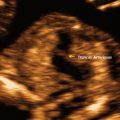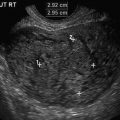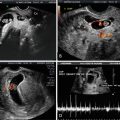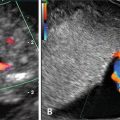Drug
Teratogenic effects
Alcohol
Fetal alcohol syndrome, growth retardation, neurological abnormality, developmental delay, intellectual impairment, microcephaly, microphthalmia, short palpebral fissures, poorly developed philtrum, thin upper lip and/or flattening of maxillary area, congenital heart defects, neural tube defects, renal abnormalities, cleft palate.
Aminopterin
A “clover-leaf” skull, large head, swept-back hair, low-set ears, prominent eyes, wide nasal bridge, meningoencephalocele, anencephaly, brachycephaly, hydrocephaly, delayed calvarial ossification, craniosynostosis, ocular hypertelorism, micrognathia, oral clefts, limb anomalies, neural tube defects.
Benzodiazepines
Oral clefts (conflicting results).
Carbamazepine
Neural tube defects.
Carbon monoxide
Stillbirth, growth retardation, and severe neurological sequelae. Possibly also VSD and pulmonic stenosis.
Cocaine
Stillbirth, placental abruption, prematurity, low birth weight, microcephaly, intraventricular hemorrhage, and developmental difficulties. An association with urinary tract anomalies was suggested.
Corticosteroids
Cleft palate (conflicting results), fetal growth impairment.
Diethylstilbestrol
Abnormal urogenital tract development, increased risk of vaginal clear cell carcinoma.
Lithium
Ebstein’s anomaly, other cardiac malformations.
Methotrexate
Intrauterine growth restriction, dysmorphic facial features, digital anomalies, limb, ear, skeletal, genital, skull, chin, central nervous system, spinal, cardiac, gastrointestinal defects, and oral clefts.
Methyl mercury, mercury sulfide
Fetal Minamata disease (microcephaly, seizures, ataxia, cognitive impairment and cerebral palsy).
Misoprostol
Moebius sequence (paralysis of the sixth and seventh cranial nerves).
Mycophenolate mofetil
Microtia, auditory canal atresia, cleft lip and palate, micrognathia, hypertelorism, ocular coloboma, short fingers, and hypoplasic nails.
PCB
Dark brown pigmentation of the skin and the mucous membrane, gingival hyperplasia, exophthalmic edematous eye, dentition at birth, abnormal calcification of the skull, rocker bottom feet, and low birth weight.
Penicillamine
Cutis laxa and inguinal hernia (conflicting results).
Phenobarbital
Cardiac defects and cleft palate.
Phenytoin
Broad nasal bridge, metopic ridging, microcephaly, cleft lip/palate, ptosis, variable degrees of hypoplasia of the distal phalanges.
Retinoids
Microtia/anotia, micrognathia, thymic, CNS and cardiac defects.
Thalidomide
Limb reduction defects, cardiac defects, facial hemangiomata, esophageal and duodenal atresia, renal defects, microtia, and anotia.
Valproic acid
Spina bifida, atrial septal defect, cleft palate, hypospadias, polydactyly, and craniosynostosis.
Warfarin
Skeletal defects (nasal hypoplasia, stippled epiphysis), growth restriction, CNS damage, eye defects, and hearing loss.
Alcohol
Ethanol (alcohol) consumption during pregnancy has been associated with a variety of birth anomalies, many of which can be demonstrated by ultrasound, as well as neurocognitive impairment.
Diagnosis of fetal alcohol spectrum disorder (FASD) requires:
1.
Prenatal and/or postnatal growth restriction (weight, length, and/or head circumference below the 10th centile).
2.
Central nervous system involvement (signs of neurological abnormality, developmental delay, behavioral effects or intellectual impairment).
3.
Characteristic facial dysmorphology with at least two of these three signs:
Microcephaly
Microphthalmia and/or short palpebral fissures.
Poorly developed philtrum, thin upper lip, and/or flattening of maxillary area.
Structural malformations other than those of the face are sometime associated with FASD, including congenital heart defects, neural tube defects, renal abnormalities, cleft palate and minor malformations such as strabismus, unusual palmar creases, and poorly formed ears. Full expression of the fetal alcohol syndrome generally occurs with chronic ingestion of at least 2 g/kg/day of alcohol. A conservative estimation of malformation risk for women consuming more than 2 g/kg/day during the first trimester is a twofold to threefold increase in risk. It is possible that minor effects would be caused by smaller amounts of alcohol; however, a safe amount of alcohol consumption in pregnancy has not been determined [18–22].
Aminopterin
Aminopterin is a folic acid antagonist closely related to methotrexate. It has been used in the 1950s as an anticancer drug and to induce abortions. Exposure to aminopterin in the first trimester has been associated with a “clover-leaf” skull with a large head, swept-back hair, low-set ears, prominent eyes and wide nasal bridge, as well as meningoencephalocele, anencephaly, brachycephaly, hydrocephaly, short stature, delayed calvarial ossification, craniosynostosis, ocular hypertelorism, micrognathia, oral clefts, limb anomalies, and neural tube defects. The critical period of exposure appears to be the sixth to eighth week of gestation [23–27]. Most of these malformations, such as anencephaly or micrognathia are recognizable by ultrasound, often in early gestation.
Benzodiazepines
Based on meta-analysis of case control studies, benzodiazepines may increase the risk for oral cleft; however, data in the literature showed conflicting results concerning this matter. Pooled data from cohort studies showed no association between fetal exposure to benzodiazepines and the risk of major malformations or oral cleft. On the basis of pooled data from case–control studies, however, there was a significant increased risk for major malformations or oral cleft alone. The absolute increase in risk for oral clefts, if it exists, appears to be very low (incidence of oral clefts in the general population is about 1 in 1000) [28, 29]. Oral clefts should be recognized with ultrasound examination of the fetal face.
Carbamazepine
Exposure to carbamazepine monotherapy in utero increases the risk of neural tube defect (NTD) to a higher rate than the general population but less than that associated with valproic acid. The risk of NTD has been estimated to increase from a baseline of about 0.1 % to a level of 0.2–1 % [30–35]. Fetal spine examination is part of any routine ultrasound anatomy study.
Carbon Monoxide Poisoning
Mild carbon monoxide poisoning was not associated with increased fetal risk, but adverse fetal outcomes were noted with severe maternal toxicity, including a high risk of stillbirth, growth restriction, and severe neurological sequelae (mental retardation, seizures, spasticity). An association with ventricular septal defect (VSD) and pulmonic stenosis was also suggested. The relative risk for birth defects in cases of carbon monoxide poisoning is unknown. Most adverse effects were observed when toxicity was severe enough to cause maternal symptoms [36–38].
Cocaine
Studies on the effect of cocaine exposure in pregnancy frequently suffer from methodological drawbacks that make the results difficult to interpret. Most women who abuse cocaine are poly-drug abusers, use alcohol, smoke, and have other risk factors for poor pregnancy outcome including poor nutrition, high gravidity, and lack of prenatal care. Cocaine use in pregnancy has been associated with an increased risk for stillbirth, placental abruption, prematurity, lower birth weight, and microcephaly compared to non-exposed infants. Associations with intraventricular hemorrhage, developmental difficulties and sudden infant death syndrome (SIDS) have also been suggested. There is disagreement on whether cocaine use increases the risk of structural malformations, although some studies show an increase in urinary tract anomalies [39–44].
Corticosteroids
Corticosteroids have been consistently shown to produce cleft palate in animals. Human studies have shown conflicting results. A possible association with oral clefts cannot be excluded. Glucocorticoids are associated with fetal growth impairment. The absolute increase in risk for oral clefts, if it exists, appears to be low (baseline 0.1 %) [45–51]. Oral clefts can be observed during examination of the fetal face.
Diethylstilbestrol
Lithium
Lithium use has been associated with cardiac malformations in general and specifically with Ebstein’s anomaly. Early information regarding teratogenic risk of lithium was derived from retrospective reports with a high risk of bias. More recent studies indicate that the risk is much lower. Risk for Ebstein’s anomaly after first-trimester exposure has been estimated as 0.05–0.1 % [54–56]. This cardiac anomaly has specific components (displacement of the septal and posterior leaflets of the tricuspid valve towards the apex of the right ventricle of the heart, resulting in the typical appearance with a large right atrium and a small right ventricle) that can be observed in a simple four-chamber view of the heart (see Chap. 11).
Methotrexate
Methotrexate is a folic acid antagonist closely related to aminopterin. Several reports on exposure to single high-dose methotrexate, in cases of failed termination of pregnancy or misdiagnosis of ectopic pregnancy, have demonstrated a variety of anomalies. The anomalies noted on prenatal ultrasonography and/or at birth included intrauterine growth restriction, dysmorphic facial features, digital anomalies, limb, ear, skeletal, genital, skull, chin, central nervous system, spinal, cardiac, gastrointestinal defects, and oral clefts. A recent prospective observational study on pregnancy outcome in women taking methotrexate (up to 30 mg/week) for rheumatic disease demonstrated that among women exposed to methotrexate post conception (188) 42.5 % had spontaneous abortions and the risk of major birth defects was elevated (6.6 %, odds ratio 3.1, 95 % CI 1.03–9.5). The observed malformations included gastroschisis, scoliosis, CCAM, cardiac malformation, renal malformations, limb defects, holoprosencephaly, and megabladder. Women planning a pregnancy after MTX therapy should be counseled to use contraception and folate supplementation during therapy and for a period of 3 months after stopping the drug [23, 25, 26, 57–63].
Methyl Mercury, Mercury Sulfide
Exposure to high levels of organic mercury in utero may cause fetal Minamata Disease, manifested by microcephaly, seizures, ataxia, cognitive impairment, and cerebral palsy. Relative risk has not been established; however, 13/220 babies born in Minamata at the time of contamination suffered from severe disease [64–66].
Misoprostol
Exposure to misoprostol is associated with Moebius sequence (paralysis of the sixth and seventh cranial nerves). Association with other malformations, such as limb reduction defects, abnormalities of frontal and temporal bones in the skull, has been suggested but not confirmed. Odds ratio for Moebius sequence was reported to be 25.32 (95 % CI 11.11–57.66). However, the true risk is less than 1–2 %. Odds ratio for limb reduction was estimated to be 11.86 (95 % CI 4.86–28.9).
Mycophenolate Mofetil
Exposure to mycophenolate mofetil has been associated with birth defects including microtia, auditory canal atresia, cleft lip and palate, micrognathia, hypertelorism, ocular coloboma, short fingers, and hypoplasic nails [67]. A higher incidence of structural malformations was seen with mycophenolate mofetil exposures during pregnancy compared to the overall kidney transplant recipient population [68]. The risk for birth defect following first-trimester exposure to mycophenolate mofetil has been reported as 26 % [68, 69].
Polychlorinated Biphenyls
Exposure to high levels of polychlorinated biphenyls (PCB) has been reported in cases of accidental human exposure to rice oil contaminated with PCBs. Exposure to high levels of PCBs is associated with dark brown pigmentation of the skin and the mucous membrane, gingival hyperplasia, exophthalmic edematous eye, dentition at birth, abnormal calcification of the skull, rocker bottom feet, and low birth weight [70].
Penicillamine
Phenobarbital
Phenobarbital use may be associated with cardiac defects and cleft palates. According to some reports, there is 6–20 % risk for malformation. Other reports did not find an increase in risk. A study of 250 cases of monotherapy exposure reported that the risk for major malformation was not greater than other anticonvulsant monotherapies [73–76].
Phenytoin
A pattern of malformations has been associated with in utero phenytoin exposure, referred to as fetal hydantoin syndrome. The pattern of malformation includes craniofacial abnormalities such as broad nasal bridge, metopic ridging, microcephaly, cleft lip/palate, and ptosis, as well as variable degrees of hypoplasia and ossification of the distal phalanges. The risk of teratogenicity with phenytoin exposure in the first trimester was defined as 10 %. However, subsequent reports have found a lower risk for malformations, and the relative risk was estimated to be about 2–3 [31, 77, 78].
Systemic Retinoids
Use of systemic retinoids such as isotretinoin in pregnancy is associated with an increased risk for malformations. The most common anomalies include microtia/anotia, micrognathia, thymic hypoplasia, aplasia or ectopic location, CNS and cardiac defects (VSD, tetralogy of Fallot, and transposition of the great vessels), most of which are recognizable by ultrasound. Due to a relatively long half-life, a waiting period of at least 1 month is recommended by some authors, while others recommended a 3-months waiting period. The risk for malformations with exposure to isotretinoin after conception was estimated to be 35 %. Forty-three percent of exposed to isotretinoin were found to have a subnormal IQ (<85) [79, 80].
Thalidomide
Valproic Acid
Use of valproic acid in pregnancy is associated with an increased risk for major malformation. The specific malformations found in association with valproic acid are spina bifida, atrial septal defect, cleft palate, hypospadias, polydactyly, and craniosynostosis. The highest relative risk compared with no use of antiepileptic drugs was for spina bifida (relative risk of 12). Relative risk for the other conditions was 2–7. Exposure to monotherapy with valproic acid was associated with a relative risk of 2.6 for major malformation (95 % CI 2.11–3.17) when compared to monotherapy with other antiepileptic drugs, 3.2 (95 % CI 2.2–4.6) when compared to untreated epileptic patients and 3.77 (95 % CI 2.18–6.52) when compared to healthy controls. The risk for malformations appears to be dose dependent. Absolute risk for spina bifida is usually quoted as 1–2 %. A more recent study had an absolute risk of 0.6 % for spina bifida [81–84]. Detailed ultrasound anatomy survey is indicated in mothers who received this medication.
Warfarin
Exposure to warfarin between 6 and 12 weeks of gestation has been associated with skeletal defects (such as nasal hypoplasia and stippled epiphysis), intrauterine growth restriction, CNS damage, eye defects, and hearing loss. Exposure after the first trimester might increase the risk of CNS defects, perhaps due to microhemorrhages. The absolute risk is not clear. One review sited a 6.4 % risk for congenital anomalies [85–88].
Infections
Maternal infections during pregnancy are very common and in most cases do not interfere with fetal development. However, there are some pathogens, including bacteria, viruses, and parasites that may lead to fetal death, birth defects, and long-term sequelae.
Cytomegalovirus
Cytomegalovirus (CMV) is one of the most common causes of intrauterine infection [89]. CMV can pass from mother to fetus through the placenta or during a vaginal delivery. Fetal CMV infection is mostly associated with maternal primary CMV infection during pregnancy. However, fetal CMV infection has been reported in recurrent infection as well, albeit with a much lower risk [90, 91]. Transmission of the virus from the mother to the fetus occurs more frequently in more advanced gestational age, but the risk for permanent sequelae is higher if transmission to the fetus occurred in the first trimester [92]. The estimated risk of transmission in cases of maternal primary CMV infection is 30–40 % [93]. Birth abnormalities, including microcephaly, ventriculomegaly, intracranial calcifications, jaundice, and deafness, are apparent in about 10 % of infants born with congenital CMV infection. The cranial ultrasound findings have been extensively described in the literature. Most of the symptomatic infants will suffer from sequelae such as sensorineural hearing loss and learning disabilities, and the most severe cases will have a high mortality rate [89, 90]. The asymptomatic cases (about 90 % of children born with congenital CMV) may develop progressive sensorineural hearing loss at a frequency of 13–15 %. In cases of recurrent infection, only 0.2–1 % of infants will be infected [93]. Of these, less than 1 % will show symptoms at birth, and 10 % of the asymptomatic newborns may experience hearing loss later in life.
Parvovirus B19
Approximately 50 % of pregnant women are believed to be immune to B19. In cases of maternal infection during pregnancy, vertical transmission has been reported as 25–33 % [94, 95]. Parvovirus does not seem to increase the risk for birth defects. However, fetal infection has been associated with fetal hydrops and death, mostly with infection before 20 weeks. The estimated risk for fetal death, if maternal infection occurs before 20 weeks gestation, is 1–9 %. If maternal infection occurs after 20 weeks gestation, the risk of hydrops is estimated to be 1 % [96].
Rubella
Due to widespread childhood vaccination, rubella infections rarely occur nowadays. Rubella in pregnancy may infect the fetus, producing congenital malformations, miscarriage or fetal death [97, 98]. The main defects associated with congenital rubella infection are cataracts, glaucoma, heart defects, deafness, pigmentary retinopathy, microcephaly, developmental delay, and radiolucent bone disease. Infants with congenital rubella syndrome usually present with more than one of these signs or symptoms. More than half of the patients will have three or more defects. Hearing impairment is the most frequently reported clinical manifestation, and is most likely to present as a single defect [97–99]. Almost all birth defects caused by rubella are associated with infections in the first 16 weeks. However, later infection has been associated with growth restriction and cases of deafness and pulmonary artery stenosis have been reported [99]. Congenital rubella survivors have an increased risk for type I diabetes, thyroid dysfunction, and progressive rubella panencephalitis [99, 100]. In cases of maternal rubella infection during the first trimester, the risk of malformation may be as high as 90 %.
Toxoplasma Gondii
The overall maternal-fetal transmission rate in cases of maternal toxoplasmosis in pregnancy was reported to be about 30 %. The risk of transmission to the fetus increases with gestational age from 6 % at 13 weeks to 72 % at 36 weeks. However, fetuses infected in early pregnancy were much more likely to show clinical signs of infection [101]. Symptoms of congenital toxoplasmosis present at birth can include a maculopapular rash, generalized lymphadenopathy, hepatomegaly, splenomegaly, jaundice, and/or thrombocytopenia. However, 70–90 % of infants with congenital infection are asymptomatic at birth and sequelae can develop months or even years later. Up to 85 % will develop chorioretinitis, 20–75 % will have some form of developmental delay and 10–30 % will have moderate hearing loss [102–104].
Treponema Pallidum
Treponema Pallidum can infect the fetus at 14 weeks gestation, and possibly earlier. The risk for fetal infection increases with gestational age. In cases of fetal infection 40–50 % of the fetuses will die in utero while 30–40 % will be born with signs of congenital syphilis [105]. Signs of congenital syphilis may include hydrops fetalis, an unexpectedly large placenta, intractable diaper rash, jaundice, hepatosplenomegaly and anemia. Hepatosplenomegaly has been reported in almost 90 % of all such babies, and jaundice in 33 % of these neonates. The jaundice may be caused by syphilitic hepatitis or by hemolytic components of the disease [106]. Generalized lymphadenopathy usually occurs in association with hepatosplenomegaly and has been described in 50 % of the patients. In one study of nine patients with congenital syphilis, eight had evidence of anemia, four had evidence of thrombocytopenia, and six had jaundice [107].
Varicella
Varicella zoster virus infection (chickenpox) is a very common childhood infection which is usually mild in children, but can be more serious in newborn babies and adults. Pregnant women in the third trimester are at higher risk for more severe disease including varicella pneumonia [108]. Fetal infection has been associated with a syndrome of congenital anomalies. Features of the congenital varicella embryopathy include skin lesions and hypopigmentation, eye defects (cataracts, microphthalmia, chorioretinitis), neurologic abnormalities (microcephaly, mental retardation, cortical atrophy), limb and muscle hypoplasia, gastrointestinal reflux, urinary tract malformations, intrauterine growth restriction, developmental delay, and cardiovascular malformations [108]. Based on the case reports and larger studies it is now believed that the sensitive period for fetal effects is from 0 to 20 weeks of pregnancy, although there are case reports of clinical embryopathy after maternal infection at up to 28 weeks of gestation [109]. The risk for congenital varicella embryopathy in cases of maternal infection before 20 weeks gestation ranges from less than 1 % [109–111] to 3 % [112]. Maternal infection in the third trimester does not cause malformation; however, it can cause severe neonatal varicella and herpes zoster in the infant. There seems to be an increase in neonatal varicella severity when maternal rash appears 7 days before to 7 days after delivery, with most severe cases when rash appeared in the mother from 4 days before and up to 2 days after delivery [109].
Physical Factors
Ionizing Radiation
High levels of ionizing radiation have been shown to interfere with fetal development. Exposure to high levels of ionizing radiation has been associated with fetal death, growth restriction, microcephaly, organ aplasia and hypoplasia, oral clefts, cataracts, CNS malformations, and mental retardation [113–116]. In very early pregnancy, especially in the preimplantation period of the pregnancy, the embryo is mainly sensitive to the lethal effect of radiation [117]. During early organogenesis the embryo is also sensitive to the growth-restricting and teratogenic effects of radiation [118], while during the early fetal period, the effects are mainly on fetal growth and CNS development [119]. Exposure to ionizing radiation is very common and is frequently associated with medical procedures [120]. While radiation exposure in pregnancy is a cause for much anxiety, in most cases, exposure to ionizing radiation in various diagnostic imaging tests is much below the 5 rad threshold, which is the commonly accepted safe level of exposure in pregnancy.
Non-ionizing Radiation
Exposure to electromagnetic fields is very common. Exposure to non-ionizing radiation can theoretically pose a risk of thermal damage, especially to the eyes (because they cannot dissipate heat efficiently). The nonthermal effects have not been clearly demonstrated. However, there is currently no indication that this type of radiation can produce malignancy or mutations [121].
Stay updated, free articles. Join our Telegram channel

Full access? Get Clinical Tree








